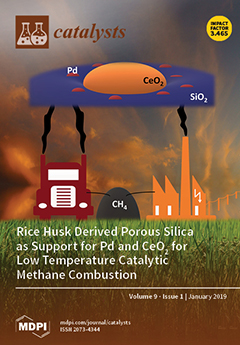Three typical Mn-based bimetallic nanocatalysts of Mn−Fe/TiO
2, Mn−Co/TiO
2, Mn−Ce/TiO
2 were synthesized via the hydrothermal method to reveal the synergistic effects of dielectric barrier discharge (DBD) plasma and bimetallic nanocatalysts on NO
x catalytic conversion. The plasma-catalyst hybrid catalysis was investigated compared with the catalytic effects of plasma alone and nanocatalyst alone. During the catalytic process of catalyst alone, the catalytic activities of all tested catalysts were lower than 20% at ambient temperature. While in the plasma-catalyst hybrid catalytic process, NO
x conversion significantly improved with discharge energy enlarging. The maximum NO
x conversion of about 99.5% achieved over Mn−Ce/TiO
2 under discharge energy of 15 W·h/m
3 at ambient temperature. The reaction temperature had an inhibiting effect on plasma-catalyst hybrid catalysis. Among these three Mn-based bimetallic nanocatalysts, Mn−Ce/TiO
2 displayed the optimal catalytic property with higher catalytic activity and superior selectivity in the plasma-catalyst hybrid catalytic process. Furthermore, the physicochemical properties of these three typical Mn-based bimetallic nanocatalysts were analyzed by N
2 adsorption, Transmission Electron Microscope (TEM), X-ray diffraction (XRD), H
2-temperature-programmed reduction (TPR), NH
3-temperature-programmed desorption (TPD), and X-ray photoelectron spectroscopy (XPS). The multiple characterizations demonstrated that the plasma-catalyst hybrid catalytic performance was highly dependent on the phase compositions. Mn−Ce/TiO
2 nanocatalyst presented the optimal structure characteristic among all tested samples, with the largest surface area, the minished particle sizes, the reduced crystallinity, and the increased active components distributions. In the meantime, the ratios of Mn
4+/(Mn
2+ + Mn
3+ + Mn
4+) in the Mn−Ce/TiO
2 sample was the highest, which was beneficial to plasma-catalyst hybrid catalysis. Generally, it was verified that the plasma-catalyst hybrid catalytic process with the Mn-based bimetallic nanocatalysts was an effective approach for high-efficiency catalytic conversion of NO
x, especially at ambient temperature.
Full article





